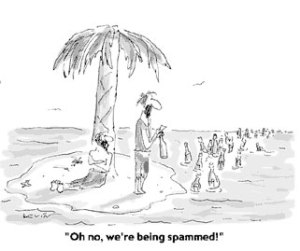THIS POST HACKED.
social media
Social Spam
 In the marketing world, everyone is all atwitter about social media. With the media world in chaos, marketing pros are trying to show our bosses and clients that we understand how to promote their product, service or cause on Facebook, Twitter and other social media outlets. We want to show that we are masters of this “bleeding edge” venue that so baffles and intrigues many senior exectutives.
In the marketing world, everyone is all atwitter about social media. With the media world in chaos, marketing pros are trying to show our bosses and clients that we understand how to promote their product, service or cause on Facebook, Twitter and other social media outlets. We want to show that we are masters of this “bleeding edge” venue that so baffles and intrigues many senior exectutives.
But a lot of what marketers are doing on social networking platforms looks suspiciously like good old fashioned spam.
Organizations that would never dream of spamming email inboxes with unwanted pitches are merrily clogging social marketing sites with social spam. News clips, pitches, press releases, petitions, infomercial videos, invitations to join groups, event announcements…
Help! It’s like someone walking into your backyard barbeque and throwing an unsolicited Tupperware party. There’s nothing wrong with Tupperware, but the timing and manners are way off.
“What’s the harm,” my social media marketing friends say. “If you’re not interested in my pitch, ignore it.”
So, what is the harm? Well, spam that interrupts a social interaction can be annoying, and the annoyance can do more harm than good for the reputation of the sponsoring organization.
What’s the harm? A person who continually interrupts my pleasure with business runs the risk of eventually earning “hidden” status, which is bad both for friendships and business networks.
What’s the harm? A constant stream of promotional blather can cause the messenger to steadily lose credibility, arguably the most valuable professional and personal commodity we possess. As with the “Boy Who Cried Wolf” parable, loss of credibility can cause friends to tune us out when we actually do have something important to say.
I understand that there is a lot of professional pressure to move in this direction. But social spamming easily can do more harm than good.
– Loveland
The Power of Social Media
 Captain Keliher and I are gearing up to give a presentation tomorrow on social media to a group of HR execs. Our premise, not surprisingly, is that social media is not a fad nor is it simply another “channel” but instead a shift in the way we communicate with one another and as a society. As I pulled in the mail today, the cover of this week’s National Journal illustrated perfectly the medium’s potential power.
Captain Keliher and I are gearing up to give a presentation tomorrow on social media to a group of HR execs. Our premise, not surprisingly, is that social media is not a fad nor is it simply another “channel” but instead a shift in the way we communicate with one another and as a society. As I pulled in the mail today, the cover of this week’s National Journal illustrated perfectly the medium’s potential power.
We’ve already seen social media affect the arc of lesser tragedies – the Abu Ghraib abuses, the Iranian uprising, the tsunami off Thailand – so it’s a reasonable conjecture to think it might have made a difference here as well.
That’s a pretty good ROI.
– Austin
How to Get A Job: Part II
A couple of weeks ago, I posted “How to Find a Job in Public Relations,” a piece that grew out of concern for graduating seniors at my university who are hitting the job market this month. Many of you kindly commented with great advice.
Tomorrow I’m going to be addressing a women’s leadership class through the Mankato YWCA around a slightly different topic: “How to Use Social Media to Get a Job.” Any job, really.
Now, I’m no expert at social media. The last time I posted an image of “the new social media prism,” Benidt quipped that it looked like a turkey on steroids. And it’s true: it does.
But it seems to me that one of the ways you can get through the loss of a position or even prepare yourself for the worst of times is to reach out now to others in your industry or profession, to long-lost colleagues and best friends, to new people who share your interests. Put together a safety net, so to speak, so if you fall you might have a softer landing spot.
Look. You already participate in the social media set. That’s why you’re reading this blog. (And we at the SRC thank you.) But if you actually comment on the posts, you become a public part of the social media landscape and we get to “know” you.
Actually, what we at the SRC don’t want to tell you is how easy it is to set up your own blog. Just go to http://www.blogspot.com or http://www.WordPress.com and if you can follow three steps, you’ll be blogging. Write about your field, your profession, your passion. (Let us know where you are and we’ll send you some “link love.”)
Do you twitter? Why not? In 140 characters or fewer, you can carry on mini-conversations with others around the world about industry openings, helpful articles, best practices in any profession (try #journchat on Monday evenings for great discussions among journalists, public relations people, students and nerdy professors.) WARNING: twitter may be addicting.
Are you on LinkedIn? Think of it as a grown-up version of MySpace. Or, how about MySpace or Facebook? Those are certainly ways to build contacts. Just remember: what you put on the Web lives forever.
What other ideas do you have for helping each other out during these uncertain economic times?